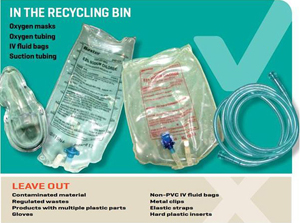|
Plastics are a significant share of hospital general
waste. It has been estimated that all plastics account
for about one third of a hospitalís general waste,
most of which is sent to landfill in Australia. Of all
plastic waste generated by a hospital, PVC medical
products such as intravenous fluid bags, tubing,
oxygen masks and blood bags, are estimated to
represent about 25%.
PVC
Is Recyclable
PVC,
also known as vinyl, can be recycled relatively easily
once it is recovered from the waste stream and has
been separated from other plastics or materials.
Although a number of recycling programs exist for PVC
products such as bottles, pipes and cable, until
recently medical products have not been recovered in
Australia. Recycling plastics saves energy and
conserves valuable raw material resources. A recycled
plastic product (including PVC) has approximately one
quarter of the embodied energy compared to an
equivalent plastic product made with virgin resin.
A pilot
PVC recovery program was initiated at Western Health
Victoria in 2009 which showed that some PVC medical
products can be separated relatively easily by
hospital staff. Recycling PVC diverts waste and useful
resources from landfill and reduces the consumption of
energy feedstocks in the production of new products.
Itís
A Matter Of Know-How
Educating and engaging staff in hospitals is crucial
to the successful recovery and recycling of PVC
medical products. It is through the collective efforts
of staff that attitudes towards waste change, the
volume of material recovered grows and contamination
of the collected PVC is minimised. These
efforts result in a higher quality recyclate for use
in new products, some of which may end up being used
in hospitals again, for example, as new
floor-coverings. How
It Works
Hospital waste is routinely separated into general and
infectious (regulated/clinical) streams. In Australia,
infectious waste is defined as materials or solutions
containing or contaminated with blood or tissue or
arising from patients with certain defined infections.
Generally, about 30 per cent of waste within operating
theatres and intensive care units is infectious; the
remainder is dealt with as general waste and sent to
landfill.
|
Under
the PVC Recovery program, the proportion of general
waste sent to landfill can be reduced. After use,
flexible PVC medical products identified for recovery
- such as IV bags, tubing and oxygen masks - can be
disposed of in dedicated PVC Recovery bins located in
the areas of the hospital that use high volumes of
these products.

The
bins are collected and transported to a PVC recycler
who washes and granulates the material. It is then
processed at high temperature and extruded into a new
product, or heated, extruded and pelletised so that it
is in a form that can be bagged and sold to a product
manufacturer for reuse.
This
type of recovered PVC produces a relatively high
quality recyclate as the original products are
generally clear rather than coloured. The recycled
material cannot be re-used in new medical products for
quality assurance reasons.
Waste Collectors And Recyclers
Third
party waste collectors and recyclers will be required
to take any collected PVC medical waste from the
hospital. There are a number of PVC recyclers in
Australia who specialise in sourcing and reprocessing
PVC product waste for recycling into new products
manufactured in Australia.
Depending on hospital location and size, these
companies may arrange collection of the waste directly
from a hospital or may engage a waste haulage company
to collect and transport it to their reprocessing
plant.
End
Uses Of Recycled PVC
PVC
medical waste recovered under this program can be
recycled into useful new products such as industrial
and garden hose, PVC compound, vinyl flooring and
carpet backing.
|
It is
estimated that Australia consumes at least 2,500
tonnes per annum of PVC in the most common medical
products. Each tonne of recycled PVC produced will
replace about one tonne of virgin PVC compound used in
new
products.
Separating PVC products from non-PVC products at the
source of waste generation produces a higher quality
of PVC recyclate since contamination by other material
has been minimised.
Improving The Result
The
following steps reduce the risk of contamination of
the PVC material by non-PVC materials and greatly
improves the recyclability of the waste:
-
Remove elastic straps and metal clips from oxygen
masks
-
Drain IV solutions from bags before disposal and
remove hard plastic inserts
-
Even where the main part of a product is PVC, if there
are numerous components made of hard plastics and
other materials, such as in giving sets, do not
include it in the PVC Recovery bins
Once
PVC waste is separated and recovered, there may be
opportunities to divert the remaining mixed plastics
waste for recycling by another party.
(Ref:
http://vinyl.org.au/about-pvc/pvcproducts/pvc-in-healthcare/pvcrecovery-in-hospitals) |
